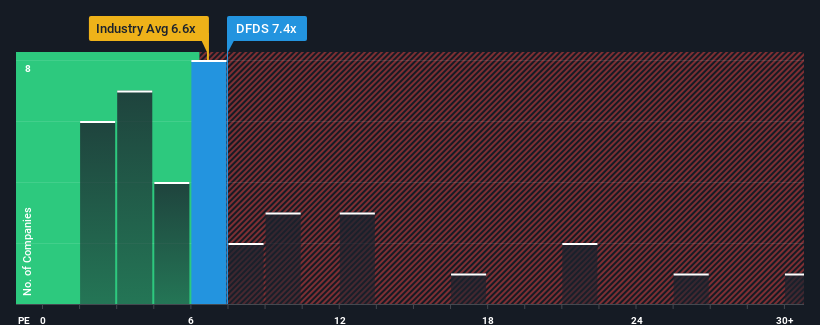- Denmark
- /
- Marine and Shipping
- /
- CPSE:DFDS
Why Investors Shouldn't Be Surprised By DFDS A/S' (CPH:DFDS) Low P/E
When close to half the companies in Denmark have price-to-earnings ratios (or "P/E's") above 14x, you may consider DFDS A/S (CPH:DFDS) as an attractive investment with its 7.4x P/E ratio. Although, it's not wise to just take the P/E at face value as there may be an explanation why it's limited.
DFDS could be doing better as its earnings have been going backwards lately while most other companies have been seeing positive earnings growth. It seems that many are expecting the dour earnings performance to persist, which has repressed the P/E. If you still like the company, you'd be hoping this isn't the case so that you could potentially pick up some stock while it's out of favour.
See our latest analysis for DFDS

Does Growth Match The Low P/E?
In order to justify its P/E ratio, DFDS would need to produce sluggish growth that's trailing the market.
If we review the last year of earnings, dishearteningly the company's profits fell to the tune of 7.9%. Still, the latest three year period has seen an excellent 284% overall rise in EPS, in spite of its unsatisfying short-term performance. Accordingly, while they would have preferred to keep the run going, shareholders would probably welcome the medium-term rates of earnings growth.
Turning to the outlook, the next year should bring diminished returns, with earnings decreasing 3.5% as estimated by the four analysts watching the company. That's not great when the rest of the market is expected to grow by 13%.
In light of this, it's understandable that DFDS' P/E would sit below the majority of other companies. However, shrinking earnings are unlikely to lead to a stable P/E over the longer term. Even just maintaining these prices could be difficult to achieve as the weak outlook is weighing down the shares.
What We Can Learn From DFDS' P/E?
It's argued the price-to-earnings ratio is an inferior measure of value within certain industries, but it can be a powerful business sentiment indicator.
We've established that DFDS maintains its low P/E on the weakness of its forecast for sliding earnings, as expected. Right now shareholders are accepting the low P/E as they concede future earnings probably won't provide any pleasant surprises. It's hard to see the share price rising strongly in the near future under these circumstances.
There are also other vital risk factors to consider before investing and we've discovered 2 warning signs for DFDS that you should be aware of.
You might be able to find a better investment than DFDS. If you want a selection of possible candidates, check out this free list of interesting companies that trade on a low P/E (but have proven they can grow earnings).
New: Manage All Your Stock Portfolios in One Place
We've created the ultimate portfolio companion for stock investors, and it's free.
• Connect an unlimited number of Portfolios and see your total in one currency
• Be alerted to new Warning Signs or Risks via email or mobile
• Track the Fair Value of your stocks
Have feedback on this article? Concerned about the content? Get in touch with us directly. Alternatively, email editorial-team (at) simplywallst.com.
This article by Simply Wall St is general in nature. We provide commentary based on historical data and analyst forecasts only using an unbiased methodology and our articles are not intended to be financial advice. It does not constitute a recommendation to buy or sell any stock, and does not take account of your objectives, or your financial situation. We aim to bring you long-term focused analysis driven by fundamental data. Note that our analysis may not factor in the latest price-sensitive company announcements or qualitative material. Simply Wall St has no position in any stocks mentioned.
About CPSE:DFDS
DFDS
Provides logistics solutions and services in Denmark and internationally.
Undervalued with moderate growth potential.
Similar Companies
Market Insights
Community Narratives




